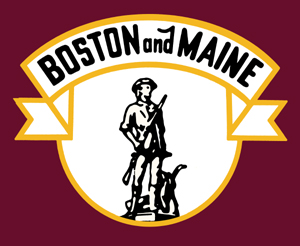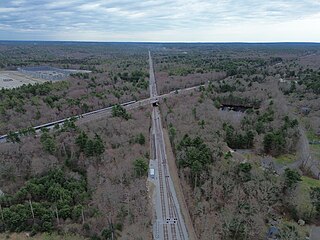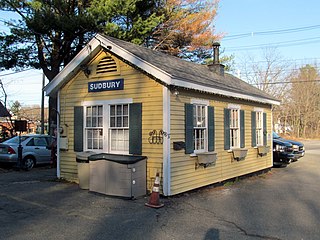
The Boston and Maine Railroad was a U.S. Class I railroad in northern New England. Originally chartered in 1835, it became part of what was the Pan Am Railways network in 1983.

The MBTA Commuter Rail system serves as the commuter rail arm of the Massachusetts Bay Transportation Authority's (MBTA's) transportation coverage of Greater Boston in the United States. Trains run over 394 mi (634 km) of track to 134 stations. It is operated under contract by Keolis, which took over operations on July 1, 2014, from the Massachusetts Bay Commuter Railroad Company (MBCR).

The Boston and Albany Railroad was a railroad connecting Boston, Massachusetts to Albany, New York, later becoming part of the New York Central Railroad system, Conrail, and CSX Transportation. The line is currently used by CSX for freight. Passenger service is provided on the line by Amtrak, as part of their Lake Shore Limited service, and by the MBTA Commuter Rail system, which owns the section east of Worcester and operates it as its Framingham/Worcester Line.

The Old Colony Railroad (OC) was a major railroad system, mainly covering southeastern Massachusetts and parts of Rhode Island, which operated from 1845 to 1893. Old Colony trains ran from Boston to points such as Plymouth, Fall River, New Bedford, Newport, Providence, Fitchburg, Lowell and Cape Cod. For many years the Old Colony Railroad Company also operated steamboat and ferry lines, including those of the Fall River Line with express train service from Boston to its wharf in Fall River where passengers boarded luxury liners to New York City. The company also briefly operated a railroad line on Martha's Vineyard, as well as the freight-only Union Freight Railroad in Boston. The OC was named after the "Old Colony", the nickname for the Plymouth Colony.
The Central Massachusetts Railroad was a railroad in Massachusetts. The eastern terminus of the line was at North Cambridge Junction where it split off from the Middlesex Central Branch of the Boston and Lowell Railroad in North Cambridge and through which it had access to North Station in Boston. From there, the route ran 98.77 miles west through the modern-day towns of Belmont, Waltham, Weston, Wayland, Sudbury, Hudson, Bolton, Berlin, Clinton, West Boylston, Holden, Rutland, Oakham, Barre, New Braintree, Hardwick, Ware, Palmer, Belchertown, Amherst, and Hadley to its western terminal junction at N. O. Tower in Northampton with the Connecticut River Railroad.
The Lexington and West Cambridge Railroad was a railroad company chartered in 1845 and opened in 1846 that operated in eastern Massachusetts. It and its successors provided passenger service until 1977 and freight service until 1980 or early 1981.
The Fall River Secondary is a freight railroad line in the U.S. state of Massachusetts, owned by the Massachusetts Bay Transportation Authority, with freight operations handled by the Massachusetts Coastal Railroad; it was formerly owned and operated by CSX Transportation. The line runs from the New Bedford Subdivision at Myricks south to Fall River along a former New York, New Haven and Hartford Railroad line. At its south end, at the Rhode Island state line in Fall River, it becomes a line of the Providence and Worcester Railroad.

The New Bedford Main Line, also known as the New Bedford Subdivision, is a freight railroad line in the U.S. state of Massachusetts owned by the Massachusetts Bay Transit Authority, with freight operations handled by the Massachusetts Coastal Railroad. The line runs from Cotley Junction where it meets the Middleboro Secondary near Weir Village south to New Bedford along a former New York, New Haven and Hartford Railroad line. The Fall River Secondary branches off at Myricks Junction.

The Middleboro Secondary is a railroad line owned by MassDOT in the U.S. state of Massachusetts. The line runs from Attleboro to Middleborough via Taunton.

The Framingham Secondary is a railroad line in the U.S. state of Massachusetts. The line runs from Mansfield northwest to Framingham along a former New York, New Haven and Hartford Railroad line. Its south end is at Amtrak's Northeast Corridor, over which CSX has trackage rights to reach the Middleboro Subdivision at Attleboro and the Boston Subdivision in Boston. Its north end is at the Framingham/Worcester Line; the Fitchburg Subdivision continues northwest from Framingham.
The Fitchburg Subdivision is a railroad line owned by CSX Transportation in the U.S. state of Massachusetts. The line runs from Fitchburg southeast to Framingham Center along a former New York, New Haven and Hartford Railroad line. Its south end is at the Boston Subdivision; the MBTA's Framingham Secondary continues southeast from Framingham.

West Concord station is an MBTA Commuter Rail station located in West Concord, Massachusetts. It is served by the Fitchburg Line. The station has two side platforms serving the line's two tracks, with mini-high platforms for accessibility. The adjacent station building, now a restaurant, is not used for railroad purposes.

The Taunton Branch Railroad was one of the earliest railroads to be established in Massachusetts, United States. It was chartered by the state in 1835 as a branch of the Boston and Providence Railroad running between Mansfield and Taunton, Massachusetts. The railroad provided a rapid overland connection between the seat of Bristol County and Boston and Providence.

The Boston, Clinton, Fitchburg and New Bedford Railroad was a railroad in Massachusetts. It was formed on June 1, 1876, when the Boston, Clinton and Fitchburg Railroad merged with the New Bedford Railroad. The Boston, Clinton and Fitchburg Railroad connected with the key railroad hubs of Worcester, Framingham, and Ayer, as well as several important industrial towns such as Fitchburg and Lowell, with the latter coming through a lease of the Framingham and Lowell Railroad. The New Bedford Railroad linked Framingham with New Bedford, which was a key deep-water port.

The Bruce Freeman Rail Trail is a partially-completed rail trail in Massachusetts. The path is a 10-foot-wide (3.0 m) paved multi-use trail, available for walking, running, biking, rollerblading, and other non-motorized uses. It follows the right-of-way of the disused Framingham and Lowell Line of the New York, New Haven and Hartford Railroad. The constructed route connects with the Bay Circuit Trail, and Phase 2D will connect with the Mass Central Rail Trail - Wayside. The total planned length of the trail—which will eventually run continuously between Lowell and Framingham—is just under 25 miles (40 km). The trail is named for Bruce Freeman, a state representative from Chelmsford who was an early political supporter of the project. The trail is owned by the Massachusetts Department of Transportation from Lowell to South Sudbury. In July 2020, MassTrails awarded Sudbury $300,000 to purchase the right-of-way from South Sudbury to the Framingham line, and Sudbury became the railbanking trail sponsor for this section in December 2020. In December 2022, Framingham signed a purchase-and-sale agreement with CSX to purchase the right-of-way in Framingham, and Framingham became the railbanking trail sponsor for this section in December 2023. The trail is maintained by the Massachusetts Department of Transportation and the communities through which the trail runs.

The Fitchburg and Worcester Railroad was a railroad in Massachusetts. It was incorporated in 1840 to provide a rail connection between Fitchburg and Worcester. Service began on February 11, 1850, running 18 miles from Fitchburg through Leominster and Sterling to Sterling Junction, where it connected with the Worcester and Nashua Railroad.

The Agricultural Branch Railroad was a railroad in Massachusetts. It was incorporated by the Legislature of Massachusetts on April 26, 1847, to provide a rail connection between Framingham and Northborough through the town of Southborough and a small portion of the city of Marlborough. Service began on December 1, 1855.
The New Bedford Railroad was a railroad in Massachusetts. It was incorporated on July 1, 1873, as a merger between the New Bedford and Taunton Railroad, the Taunton Branch Railroad, and the Middleborough and Taunton Railroad. The main line ran from a junction with the Boston and Providence Railroad in Mansfield through the towns of Norton, Taunton, Berkley, Lakeville, and Freetown to the deep-water whaling port of New Bedford. The railroad also had several branches, including the former Middleborough and Taunton Railroad, which ran from Weir Village, Taunton into Middleborough through Raynham, and a shortcut to Providence via the Boston and Providence Railroad which ran from Taunton to Attleborough through Norton.
The Taunton and Middleborough Railroad was a railroad in Massachusetts. It was incorporated in 1848 to connect the Taunton Branch Railroad in Weir Village, Taunton with the Fall River Railroad and newly built Cape Cod Branch Railroad in Middleborough through the town of Raynham. In 1853, the railroad changed its name to the Middleborough and Taunton Railroad.

South Sudbury was a commuter rail station in Sudbury, Massachusetts. It was located at the junction of the Central Massachusetts Railroad and the Framingham and Lowell Railroad slightly north of Boston Post Road in South Sudbury. The Boston and Maine Railroad station was incorporated into the MBTA Commuter Rail through subsidies in 1965. The station was closed in November 1971 when the branch's last remaining round trip was discontinued. The 1952-built station building was a private business until its closure in 2019, and the building is now abandoned. In August 2023 the Massachusetts Department of Conservation and Recreation offered the building to the Town of Sudbury at no cost.















